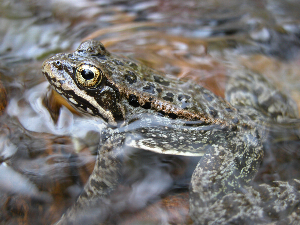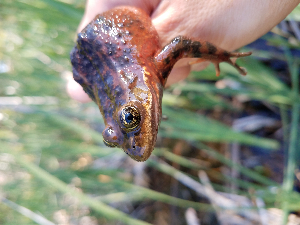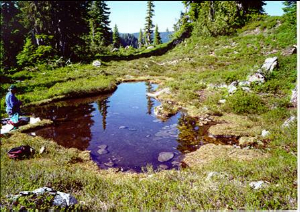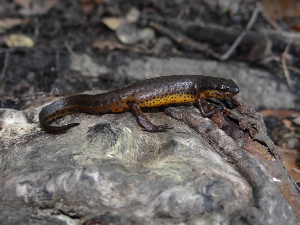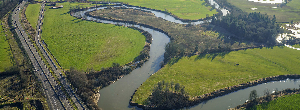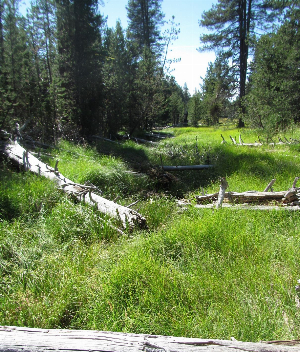Search ARMI Database
Search term(s)
Contribution Number
Search Results
117 record(s) found.
Data Release Capture-mark-recapture data for Oregon spotted frogs [Rana pretiosa] along the Deschutes River, Oregon, 2016-2019
Authors: Jennifer C Rowe; Adam Duarte; Christopher A Pearl; Brome McCreary; P K Haggerty; Michael J Adams
Date: 2021-06-04 | Outlet: Ecosphere, v. 12, no. 6, p. e03634
Altered flow regimes can contribute to dissociation between life history strategies and environmental conditions, leading to reduced persistence reported for many wildlife populations inhabiting regulated rivers. The Oregon spotted frog Rana pretiosa is a threatened species occurring in floodplains, ponds, and wetlands in the Pacific Northwest with a core range in Oregon, USA. All life stages of R. pretiosa are reliant on aquatic habitats, and inundation patterns across the phenological timeline can have implications for population success. We conducted capture–mark–recapture (CMR) sampling of adult and subadult R. pretiosa at three sites along the Deschutes River downstream from two dams that regulate flows. We related the seasonal extent of inundated habitat at each site to monthly survival probabilities using a robust design CMR model. We also developed matrix projection models to simulate population dynamics into the future under current river flows. Monthly survival was strongly associated with the extent and variability of inundated habitat, suggesting some within-season fluctuations at higher water levels could be beneficial. Seasonal survival was lowest in the winter for all three sites, owing to limited water availability and the greater number of months within this season relative to other seasons. Population growth for the two river-connected sites was most strongly linked to adult survival, whereas population growth at the river-disconnected site was most strongly tied to survival in juvenile stages. This research identifies population effects of seasonally limited water and highlights conservation potential of enhancing survival of particularly influential life stages.
Papers & Reports Late-season movement and habitat use by Oregon spotted frog (Rana pretiosa) in a large reservoir in Oregon, USA
Authors: Christopher A Pearl; Jennifer C Rowe; Brome McCreary; Michael J Adams
Date: 2022-03-04 | Outlet: Journal of Herpetology
Dam-created reservoirs are common landscape features that can provide habitat for amphibians, but their water level fluctuations and nonnative predators can differ markedly from more natural habitats. We compared fall movement and habitat use by the Oregon Spotted Frog (Rana pretiosa) in the reservoir pool with nearby river and pond habitats at Crane Prairie Reservoir in central Oregon, USA. Movement rate of frogs in the river and ponds declined as water temperature cooled. Reservoir frogs moved further than those in the river or ponds, and their movement rate increased as water temperature cooled. Most frog locations across all site types were in aquatic herbaceous vegetation. We did not find shifts in habitat between early and late fall. Increased movement and the lack of habitat shift in our reservoir frogs deeper into fall contrast with R. pretiosa in non-reservoir sites in this study and others. Consistent use of vegetation by reservoir frogs throughout the fall could indicate cover use in presence of fish predators. Our study provides additional detail on the range of habitats used by R. pretiosa in fall and suggests areas for further work to improve survival in constructed sites with abundant fish predators.
Papers & Reports An updated assessment of status and trend for Cascades Frog in Oregon
Authors: Adam Duarte; Christopher A Pearl; Brome McCreary; Jennifer C Rowe; Michael J Adams
Date: 2021-08-31 | Outlet: Herpetological Conservation and Biology
Conservation efforts need reliable information concerning the status of a species and their trends to help identify which species are in most need of assistance. We completed a comparative evaluation of the occurrence of breeding for Cascades Frog (Rana cascadae), an amphibian that is being considered for federal protection under the U.S. Endangered Species Act. Specifically, in 2018–2019 we resurveyed 67 sites that were surveyed approximately 15 y prior and fit occupancy models to quantify the distribution of R. cascadae breeding in the Cascade Range, Oregon, USA. Furthermore, we conducted a simulation exercise to assess the power of sampling designs to detect declines in R. cascadae breeding at these sites. Our analysis of field data combined with our simulation results suggests that if there was a decline in the proportion of sites used for R. cascadae breeding in Oregon, it was likely a < 20% decline across our study period. Our results confirm that while R. cascadae detection probabilities are high, methods that allow the sampling process to be explicitly modeled are necessary to reliably track the status of the species. This study demonstrates the usefulness of investing in baseline information and data quality standards to increase capacity to make similar comparisons for other species in a timeframe that meet the needs of land managers and policy makers.
Papers & Reports Demography of the Oregon spotted frog along a hydrologically modified river
Authors: Jennifer C Rowe; Adam Duarte; Christopher A Pearl; Brome McCreary; P K Haggerty; John W Jones; Michael J Adams
Date: 2021-06-21 | Outlet: Ecosphere
Altered flow regimes can contribute to dissociation between life history strategies and environmental conditions, leading to reduced persistence reported for many wildlife populations inhabiting regulated rivers. The Oregon spotted frog (Rana pretiosa) is a threatened species occurring in floodplains, ponds, and wetlands in the Pacific Northwest with a core range in Oregon, USA. All life stages of R. pretiosa are reliant on aquatic habitats, and inundation patterns across the phenological timeline can have implications for population success. We conducted capture-mark-recapture (CMR) sampling of adult and subadult R. pretiosa at three sites along the Deschutes River downstream from two dams that regulate flows. We related the seasonal extent of inundated habitat at each site to monthly survival probabilities using a robust design CMR model. We also developed matrix projection models to simulate population dynamics into the future under current river flows. Monthly survival was strongly associated with the extent and variability of inundated habitat, suggesting some within-season fluctuations at higher water levels could be beneficial. Seasonal survival was lowest in the winter for all three sites, owing to limited water availability and the greater number of months within this season relative to other seasons. Population growth for the two river-connected sites was most strongly linked to adult survival, whereas population growth at the river-disconnected site was most strongly tied to survival in juvenile stages. This research identifies population effects of seasonally limited water and highlights conservation potential of enhancing survival of particularly influential life stages.
Papers & Reports Enhanced between-site biosecurity to minimize herpetofaunal disease-causing pathogen transmission
Authors: Deanna H Olson; K H Haman; M J Gray; Reid N Harris; T Thompson; M Iredale; M Christman; J Williams; Michael J Adams; Jennifer R Ballard
Date: 2021 | Outlet: Herpetological Review
We describe biotic and abiotic factors that interact with field work to contribute to gradients in human-mediated herpetofaunal pathogen transmission (i.e., translocation) risk between sites. Using biotic and abiotic criteria, we identify site conditions that correspond to high risk for pathogen import [to a site] or high risk for pathogen export [from a site] for implementation of enhanced between-site biosecurity procedures to forestall human-mediated pathogen transmission. Our field-site criteria are based on seven contexts of the pathogen (occurrence, habitat), host(s) (occurrence, habitat, species richness), and geography (distance/topography, geopolitical land use) (Table 1). We do not provide an explicit decision tree because site contexts can be complex, and single contexts may be weighted heavily in some biosecurity decisions, warranting case-by-case decisions. A more conceptual decision tree (Fig. 1) about pathogen export or import can be more flexibly applied as site context vary. Our aim is to provide a rapid process to develop a qualitative narrative to support decisions for between-site herpetological disease biosecurity.
Data Release North Coast and Cascades Network consolidated amphibian database (1984-2005)
Authors: Stephanie K Galvan; Michael J Adams; B Samora; S E Stonum; P J Happe; R S Glesne; A Rawhouser
Date: 2020-10-20
This data set is an amalgamation of twenty-nine original data sets, which represent amphibian surveys in the seven national parks comprising the North Coast and Cascades Network (NCCN) of the National Park Service. The data were collected from 1984-2005, and include the localities of 19 species of amphibians at various life stages, 18 native to the Pacific Northwest and one invasive species
Papers & Reports Estimation of metademographic rates and landscape connectivity for a conservation-reliant anuran
Authors: Adam Duarte; James T Peterson; Christopher A Pearl; Jennifer C Rowe; Brome McCreary; Stephanie K Galvan; Michael J Adams
Outlet: Landscape Ecology
Context Amphibian conservation efforts commonly assume populations are tied to waterbodies that collectively function as a metapopulation. This assumption is rarely evaluated, and there is a need to understand the degree of connectivity among patches to appropriately define, manage, and conserve biological populations.
Objectives Our objectives were to quantify local persistence, colonization, and recruitment (metademographic rates) in relation to habitat attributes, evaluate the influence of the spatial arrangement of patches on landscape-scale population dynamics, and estimate the scale at which metapopulation dynamics are occurring for the Oregon spotted frog (Rana pretiosa).
Methods We collected R. pretiosa detection/non-detection data and habitat information from 93 sites spread throughout the species’ core extant range in Oregon, USA, 2010–2018. We developed a spatial multistate dynamic occupancy model to analyze these data.
Results Results indicated the proportion of sites occupied by R. pretiosa was relatively stable despite regular turnover in site occupancy. Connectivity was highest when the distance between sites was within 4.49–https://7.70 km, and populations within 1 km are at the appropriate spatial scale for effective population management. Rana pretiosa metademographic rates were strongly tied to water availability, vegetation characteristics, and beaver dams.
Conclusions Our analysis provides critical information to identify the appropriate spatial scale for effective population management, estimates the distance at which populations are connected, and quantifies the effects of hypothesized threats to species at a landscape scale. We believe this type of model can inform conservation and management strategies for multiple species.
Objectives Our objectives were to quantify local persistence, colonization, and recruitment (metademographic rates) in relation to habitat attributes, evaluate the influence of the spatial arrangement of patches on landscape-scale population dynamics, and estimate the scale at which metapopulation dynamics are occurring for the Oregon spotted frog (Rana pretiosa).
Methods We collected R. pretiosa detection/non-detection data and habitat information from 93 sites spread throughout the species’ core extant range in Oregon, USA, 2010–2018. We developed a spatial multistate dynamic occupancy model to analyze these data.
Results Results indicated the proportion of sites occupied by R. pretiosa was relatively stable despite regular turnover in site occupancy. Connectivity was highest when the distance between sites was within 4.49–https://7.70 km, and populations within 1 km are at the appropriate spatial scale for effective population management. Rana pretiosa metademographic rates were strongly tied to water availability, vegetation characteristics, and beaver dams.
Conclusions Our analysis provides critical information to identify the appropriate spatial scale for effective population management, estimates the distance at which populations are connected, and quantifies the effects of hypothesized threats to species at a landscape scale. We believe this type of model can inform conservation and management strategies for multiple species.
Data Release Oregon spotted frog (Rana pretiosa) monitoring data for metademographic analysis 2010-2018, Oregon: U.S. Geological Survey Data Release
Authors: Jennifer C Rowe; Adam Duarte; James T Peterson; Christopher A Pearl; Brome McCreary; Stephanie K Galvan; Michael J Adams
Date: 2020-05-05 | Outlet: ScienceBase
This dataset contains information from surveys conducted 2010-2018 by USGS as part of a long-term Oregon spotted frog monitoring effort in the central Oregon range. Data consist of site, survey, habitat, and species detection covariates, as well as inter-site distance measurements.
Data Release Annotated bibliography of grazing effects on amphibians and their habitats (ver. 2.0, February 2022)
Authors: Jennifer C Rowe; Christopher A Pearl; Michael J Adams; Brome McCreary
Date: 2022-02-10 | Outlet: Science Base
Livestock grazing is one of the most common land uses in the western United States, where multiple amphibians of conservation concern use habitats that are grazed. Despite the common intersection of grazing and sensitive amphibian species, there are very few reviews of research related to the issue. USGS researchers compiled and summarized literature pertaining to livestock grazing effects on amphibians and their habitats, with an emphasis on wetland-breeding species in the western United States. Users of the annotated bibliography can utilize an integrated search tool with user-defined criteria to query records and output results. This tool aids users in synthesizing research related to a range of specific questions and should assist land managers in evaluating and implementing grazing while maintaining habitat for wetland amphibians.
Data Release Cascades frog (Rana cascadae) historical site surveys in the Oregon Cascade Range, 2018-2019
Authors: Michael J Adams; Christopher A Pearl; Brome McCreary; Jennifer C Rowe
Date: 2019-10-11 | Outlet: Science Base
We used visual surveys to document the presence of all life stages of Cascades frog (Rana cascadae) at historically occupied sites. We surveyed 67 sites 1-2 times between May and August of 2018 and 2019. This effort was a continuation of 2001-2004 surveys conducted at the same site pool. This dataset includes counts of amphibians, reptiles, and fish observed during each site survey, as well as habitat covariates.
Data Release Foothill yellow-legged frog (Rana boylii) surveys in Oregon 2019
Authors: Michael J Adams; Christopher A Pearl; Jennifer C Rowe; Brome McCreary; Matthew B Laramie; David S Pilliod
Date: 2019-11-01 | Outlet: Science Base
We used visual surveys and environmental DNA (eDNA) sampling to document the presence of all life stages of foothill yellow-legged frogs (Rana boylii) at historically occupied sites. We visited 52 stream reaches (sites) on federal and private lands between June and September of 2019. This dataset includes counts of amphibians, crayfish, and fish observed during each site survey, as well as habitat and water sampling covariates.
Data Release Oregon spotted frog (Rana pretiosa) telemetry and habitat use at Klamath Marsh National Wildlife Refuge in Oregon, USA
Authors: Christopher A Pearl; Jennifer C Rowe; Brome McCreary; Michael J Adams
Date: 2019-12-13 | Outlet: Science Base
We used radio-telemetry to study late-season movement and habitat use by Oregon spotted frogs (Rana pretiosa) at Klamath Marsh National Wildlife Refuge in Oregon. This data release includes frog location and habitat use data, as well as visualizations of telemetry data. Tracking events occurred roughly weekly between August and December of 2017.
Data Release Nutrients, estrogenicity, and fecal indicators in surface water collected from wetlands in the Klamath Marsh National Wildlife Refuge, Oregon, 2017-2018
Authors: Jennifer C Rowe; Kelly L Smalling; Christopher A Pearl; C E Givens; A J Sperry; Michael J Adams
Date: 2019-12-13 | Outlet: Science Base
The data was gathered to determine the effects of cattle grazing on wetland water quality in the Klamath National Wildlife Refuge in Oregon. Surface water samples from sites representing a range of grazing histories were collected between June and October in 2017 and 2018. Samples were analyzed for nutrients (ammonia, nitrate plus nitrite, nitrite and orthophosphate), total coliforms, E. coli, enterococci and estrogenicity by US Geological Survey laboratories. Basic water quality parameters such as temperature, pH, turbidity and specific conductance were also collected in the field during each site visit. Quality assurance samples (blanks and replicates) as well as method information is also included in the data release.
Data Release Telemetry and habitat data for Oregon spotted frogs (Rana pretiosa) in Oregon, USA
Authors: Christopher A Pearl; Brome McCreary; Jennifer C Rowe; Michael J Adams
Date: 2018-09-27 | Outlet: Science Base
We used radio-telemetry to study late-season movement and habitat use by the Oregon spotted frog (Rana pretiosa) at 9 sites from 4 populations along the Cascade Mountains in Oregon. This dataset includes individual frog morphometrics, location data, and habitat use during each tracking event that occurred roughly weekly between September and January of 2011, 2012, and 2016.
Papers & Reports Amphibian chytrid prevalence on boreal toads in SE Alaska and NW British Columbia: tests of habitat, life stages, and temporal trends
Authors: Blake R Hossack; Michael J Adams; R K Honeycutt; Jami J Belt; S Pyare
Date: 2020 | Outlet: Diseases of Aquatic Organisms 137:159-165
Tracking and understanding variation in pathogens such as Batrachochytrium dendrobatidis
(Bd), the agent of amphibian chytridiomycosis, which has caused population declines
globally, is a priority for many land managers. However, relatively little sampling of amphibian
communities has occurred at high latitudes. We used skin swabs collected during 2005?2017 from
boreal toads Anaxyrus boreas (n = 248), in southeast Alaska (USA; primarily in and near Klondike
Gold Rush National Historical Park [KLGO]) and northwest British Columbia (Canada) to determine
how Bd prevalence varied across life stages, habitat characteristics, local species richness,
and time. Across all years, Bd prevalence peaked in June and was >3 times greater for adult toads
(37.5%) vs. juveniles and metamorphs (11.2%). Bd prevalence for toads in the KLGO area, where
other amphibian species are rare or absent, was highest from river habitats (55.0%), followed by
human-modified upland wetlands (32.3%) and natural upland wetlands (12.7%)—the same rankorder
these habitats are used for toad breeding. None of the 12 Columbia spotted frogs Rana
luteiventris or 2 wood frogs R. sylvatica from the study area tested Bd-positive, although all were
from an area of low host density where Bd has not been detected. Prevalence of Bd on toads in the
KLGO area decreased during 2005?2015. This trend from a largely single-species system may be
encouraging or concerning, depending on how Bd is affecting vital rates, and emphasizes the
need to understand effects of pathogens before translating disease prevalence into management
actions.
(Bd), the agent of amphibian chytridiomycosis, which has caused population declines
globally, is a priority for many land managers. However, relatively little sampling of amphibian
communities has occurred at high latitudes. We used skin swabs collected during 2005?2017 from
boreal toads Anaxyrus boreas (n = 248), in southeast Alaska (USA; primarily in and near Klondike
Gold Rush National Historical Park [KLGO]) and northwest British Columbia (Canada) to determine
how Bd prevalence varied across life stages, habitat characteristics, local species richness,
and time. Across all years, Bd prevalence peaked in June and was >3 times greater for adult toads
(37.5%) vs. juveniles and metamorphs (11.2%). Bd prevalence for toads in the KLGO area, where
other amphibian species are rare or absent, was highest from river habitats (55.0%), followed by
human-modified upland wetlands (32.3%) and natural upland wetlands (12.7%)—the same rankorder
these habitats are used for toad breeding. None of the 12 Columbia spotted frogs Rana
luteiventris or 2 wood frogs R. sylvatica from the study area tested Bd-positive, although all were
from an area of low host density where Bd has not been detected. Prevalence of Bd on toads in the
KLGO area decreased during 2005?2015. This trend from a largely single-species system may be
encouraging or concerning, depending on how Bd is affecting vital rates, and emphasizes the
need to understand effects of pathogens before translating disease prevalence into management
actions.
Papers & Reports Batrachochytrium salamandrivorans (Bsal) not detected in an intensive survey of wild North American amphibians
Authors: Hardin J Waddle; Daniel A Grear; Brittany A Mosher; G ra Campbell; Michael J Adams; Adam R Backlin; William J Barichivich; Adrianne B Brand; Gary Bucciarelli; Daniel L Calhoun; T Chestnut; J M Davenport; A Dietrich; Robert N Fisher; Brad M Glorioso; Brian J Halstead; Marc P Hayes; R K Honeycutt; Blake R Hossack; Patrick M Kleeman; J A Lemos-Espinal; Jeffrey M Lorch; Brome McCreary; Erin Muths; Christopher A Pearl; Katherine LD Richgels; C W Robinson; Mark F Roth; Jennifer C Rowe; Walt J Sadinski; Brent H Sigafus; I Stasiak; S Sweet; Susan C Walls; C J Watkins-Colwell; C Le White; L A Williams; Megan E Winzeler
Date: 2020-08-03 | Outlet: Scientific Reports 10:13012
Papers & Reports Floodplains provide important amphibian habitat despite multiple ecological threats
Authors: M Holgerson; Adam Duarte; Marc P Hayes; Michael J Adams; J Tyson; K Douville; A Strecker
Date: 2019-09-03 | Outlet: Ecosphere
Floodplain ponds and wetlands are productive and biodiverse ecosystems, yet they face multiple threats including altered hydrology, land use change, and non-native species. Protecting and restoring important floodplain ecosystems requires understanding how organisms use these habitats and respond to altered environmental conditions. We developed Bayesian models to evaluate occupancy of six amphibian species across 103 off-channel aquatic habitats in the Chehalis River floodplain, Washington State, USA. The basin has been altered by changes in land use, reduced river-wetland connections, and the establishment of non-native American bullfrogs (Rana catesbeiana = Lithobates catesbeianus) and centrarchid fishes, all of which we hypothesized could influence native amphibian occupancy. Despite potential threats, the floodplain habitats had relatively high rates of native amphibian occupancy, particularly when compared to studies from non-floodplain habitats within the species’ native ranges. The biggest challenge for native amphibians appears to be non-native centrarchid fishes, which strongly reduced occupancy of two native amphibians: the northern red-legged frog (Rana aurora) and the northwestern salamander (Ambystoma gracile). Emergent vegetative cover increased occupancy probability for all five native amphibian species, indicating that plant-management may offer a strategy to counter the negative effect of centrarchids by providing refuge from predation. We found that temporary and permanent hydroperiod sites supported different species, hence both should be conserved on the landscape. Lastly, human-created and natural ponds had similar amphibian occupancy patterns, suggesting that pond construction offers a viable strategy for adding habitats to the floodplain landscape. Overall, floodplain ponds and wetlands provide important amphibian habitat, and we offer management strategies that will bolster amphibian occupancy in an altered floodplain landscape.
Data Release Long-term amphibian monitoring data from the Willamette Valley, Oregon (2004-2015): U.S. Geological Survey data release
Authors: Michael J Adams; Christopher A Pearl; Brome McCreary; Stephanie K Galvan; Jennifer C Rowe; Adam Duarte; James T Peterson
Date: 2019-03-28 | Outlet: ScienceBase
This dataset contains information from surveys conducted 2004-2015 by USGS as part of a long-term amphibian monitoring effort in the Willamette Valley, Oregon. Data consist of site, survey, habitat, and species detection covariates.
Data Release Oregon spotted frog (Rana pretiosa) observations in Oregon, 2016-2024: U.S. Geological Survey data release
Authors: Michael J Adams; Christopher A Pearl; Brome McCreary; Jennifer C Rowe
Date: 2020-03-05 | Outlet: ScienceBase
This dataset contains information from surveys conducted 2016-2024 by USGS as part of an ongoing Oregon spotted frog (Rana pretiosa) monitoring effort in Oregon. USGS research activities 2016-2024 were divided into seven study design categories: breeding (egg mass counts), mid-level (visual encounter surveys for occupancy monitoring), apex (mark-recapture), telemetry, trapping, water quality (skin microbiome swabbing), and genetics (egg mass embryo or toe-clip tissue samples). Data consist of Oregon spotted frog observations aggregated by date, location, life stage, sex, and project. These data were compiled from multiple studies employing different survey methods, thus we caution users that counts are not directly comparable among projects; any counts may represent multiple detections of the same individual.
Data Release Oregon Spotted Frog (Rana pretiosa) Monitoring at Jack Creek 2015-2018 (final): U.S. Geological Survey data release
Authors: Michael J Adams; Christopher A Pearl; Brome McCreary; Stephanie K Galvan; Jennifer C Rowe
Date: 2019-02-11 | Outlet: ScienceBase
This dataset contains information from mark-recapture and egg mass surveys conducted 2015-2018 by USGS as part of an ongoing Oregon spotted frog (Rana pretiosa) monitoring effort at Jack Creek, Klamath County, Oregon. Data consist of spotted frog counts (handled by surveyors) aggregated by date, location, life stage, and sex, as well as data on environmental conditions at the time each survey. Note that due to updates in access permissions, surveyed area within each site varies over time. Thus, counts are not comparable among year, as surveyed area was not held constant.

